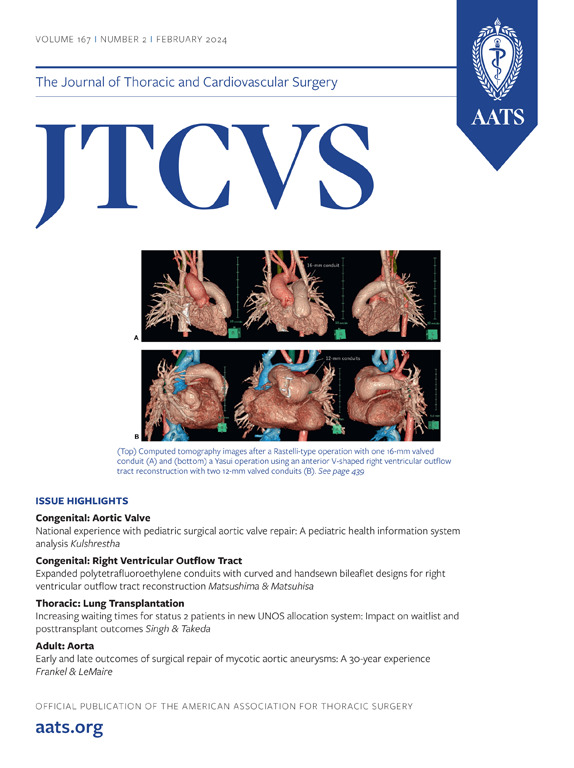食管癌侵犯邻近脏器联合切除的手术及远期疗效:90例连续病例的经验。
IF 4.4
1区 医学
Q1 CARDIAC & CARDIOVASCULAR SYSTEMS
Journal of Thoracic and Cardiovascular Surgery
Pub Date : 2025-10-01
DOI:10.1016/j.jtcvs.2025.01.017
引用次数: 0
摘要
目的:评估食管癌(EC)联合脏器切除术的可行性和长期生存率:评估食管癌(EC)联合器官切除术的可行性和长期生存率:背景:对于侵犯邻近器官的食管癌,最佳治疗策略尚未确定:方法:2003-2023年间,我院对90例侵犯邻近器官的食管癌患者进行了诱导治疗后联合器官切除术。评估了短期和长期预后,并进行了生存分析,以确定该组患者的预后参数:大多数患者为原发性肿瘤(78.9%对21.1%为复发性疾病)。75.6%的患者切除了气管/支气管,24.4%的患者切除了大血管,5.6%的患者同时切除了气管和支气管。除一名患者外,其他患者均在诱导治疗前接受了化疗或化放疗,并进行了R0切除。总并发症发生率(Clavien-Dindo≥II级)为54.4%,院内死亡率为2.2%(30天和90天死亡率分别为0%和2.2%)。在死亡病例中,47例(87.0%)死于EC,7例(13.0%)死于其他原因。无病生存期中位数为6.5个月,总生存期(OS)为18.9个月。气管/支气管切除的2年生存率为47.2%,大血管受累的2年生存率为38.4%,两者均受累的2年生存率为37.5%。OS的单变量分析显示,手术时间(HR=2.11,P=0.0080)、失血量(HR=2.85,P=0.0003)、气管全层切除(HR=3.51,P=0.0045)、ypT(HR=2.04,P=0.022)和病理反应(HR=2.77,P=0.0089)与OS有显著相关性:结论:如果对患者进行高度筛选,联合脏器切除术可能是一种可行且有前景的选择,可作为侵犯邻近脏器的EC多学科治疗的一部分。本文章由计算机程序翻译,如有差异,请以英文原文为准。
Surgical and long-term outcomes of combined organ resection for esophageal cancer invading adjacent organs: Experience of 90 consecutive cases
Objective
To evaluate the feasibility of and long-term survival with combined organ resection for esophageal cancer (EC). The optimal treatment strategy for EC that is invading adjacent organs is not established.
Methods
Ninety patients with EC invading adjacent organs who underwent combined organ resection after induction treatments during the time period 2003-2023 in our institute were eligible for the study. Short- and long-term outcomes were assessed, and survival analysis was performed to identify prognostic parameters in this cohort.
Results
Most patients had primary tumors (78.9% vs 21.1% with recurrent disease). The resected organs were the trachea/bronchus in 75.6%, large vessels in 24.4%, and both in 5.6%. All but 1 patient underwent chemotherapy or chemoradiotherapy as prior induction treatment, and had R0 resection. The overall complication rate (Clavien-Dindo grade II or greater) was 54.4%, and in-hospital mortality was 2.2% (30- and 90-day mortality: 0% and 2.2%, respectively). Of the deaths, 47 (87.0%) were attributed to EC and 7 (13.0%) to other causes. Median disease-free survival was 6.5 months, and overall survival (OS) was 18.9 months. The 2-year OS values were 47.2% with trachea/bronchus resection, 38.4% with large-vessel involvement, and 37.5% if both were involved. Univariate analysis of OS demonstrated significant associations of operation time (hazard ratio [HR], 2.11; P = .0080), blood loss (HR, 2.85; P = .0003), all-layer tracheal resection (HR, 3.51; P = .0045), ypT (HR, 2.04; P = .022), and pathologic response (HR, 2.77; P = .0089).
Conclusions
If patient selection is highly selected, combined organ resection may be a feasible and promising option as a part of the multidisciplinary treatment for EC invading an adjacent organ.
求助全文
通过发布文献求助,成功后即可免费获取论文全文。
去求助
来源期刊
CiteScore
11.20
自引率
10.00%
发文量
1079
审稿时长
68 days
期刊介绍:
The Journal of Thoracic and Cardiovascular Surgery presents original, peer-reviewed articles on diseases of the heart, great vessels, lungs and thorax with emphasis on surgical interventions. An official publication of The American Association for Thoracic Surgery and The Western Thoracic Surgical Association, the Journal focuses on techniques and developments in acquired cardiac surgery, congenital cardiac repair, thoracic procedures, heart and lung transplantation, mechanical circulatory support and other procedures.

 求助内容:
求助内容: 应助结果提醒方式:
应助结果提醒方式:


